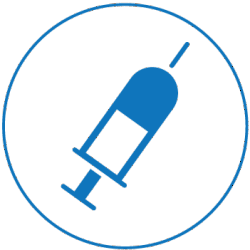Blood Draw/Phlebolomy Certification
This course includes practical training, blood drawing, and instruction on safety standards and techniques. The goal is to gain the skills and knowledge needed to become a certified phlebotomist, able to draw blood safely and accurately.

Learning Objective
- Understanding anatomy and vein selection
- Demonstrate proper technique
- Ensure patient safety
Course Overview
Learn the essential skills and techniques for performing venipuncture.

Introduction
Phlebotomy, also known as a blood draw or venipuncture, is the procedure of drawing blood from a vein, typically using a needle, for laboratory testing, transfusions, or research. It’s a vital part of modern medicine, used for diagnosing and treating various conditions.
Purpose of Phlebotomy:
-
Diagnostic Testing:Blood samples are crucial for diagnosing a wide range of medical conditions, from infections and autoimmune diseases to genetic disorders.
-
Monitoring Treatment:Regular blood draws help monitor the effectiveness of treatments and adjust dosages as needed.
-
Blood Transfusions:Phlebotomy can be used to collect blood for transfusions to patients with blood loss or anemia.
-
Blood Donation:Phlebotomy is essential for blood donation, providing a supply for patients in need of transfusions.
-
Therapeutic Phlebotomy:In certain cases, phlebotomy is used therapeutically to remove excess red blood cells or other components of the blood to treat conditions like polycythemia or hemochromatosis.
Procedure:
- Identifying the Vein: A phlebotomist will carefully select a vein, usually in the arm or hand, by inspection and palpation.
- Applying a Tourniquet: A tourniquet is placed on the upper arm to make the vein more visible and easier to puncture.
- Cleaning the Site: The skin over the vein is cleaned with an antiseptic.
- Inserting the Needle: A needle is inserted into the vein, and the blood is collected into a tube or syringe.
- Removing the Tourniquet and Needle: The tourniquet is removed, and the needle is withdrawn once the blood sample is collected.
- Applying Pressure: Pressure is applied to the puncture site to stop any bleeding.
Important Considerations:
- Safety: Phlebotomy is a safe procedure when performed by trained professionals following established guidelines.
- Patient Comfort: Phlebotomists are trained to minimize discomfort during the procedure.
- Possible Side Effects: Some patients may experience mild side effects like bruising, soreness, or a vasovagal reaction (feeling faint).
Who Performs Phlebotomy?
Phlebotomy is typically performed by phlebotomists, who are healthcare professionals trained in drawing blood samples. They may work in hospitals, clinics, laboratories, or blood donation centers
